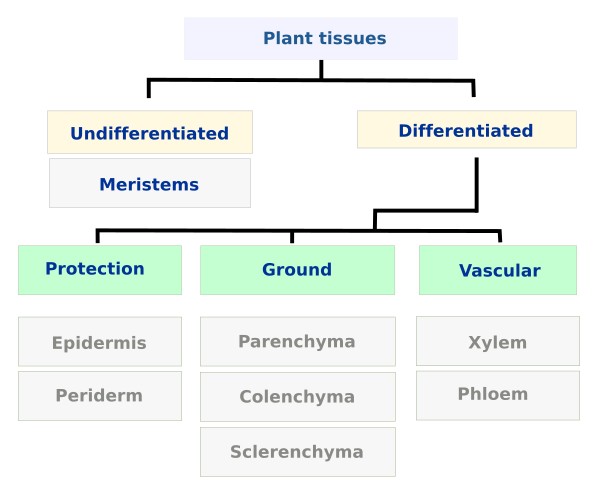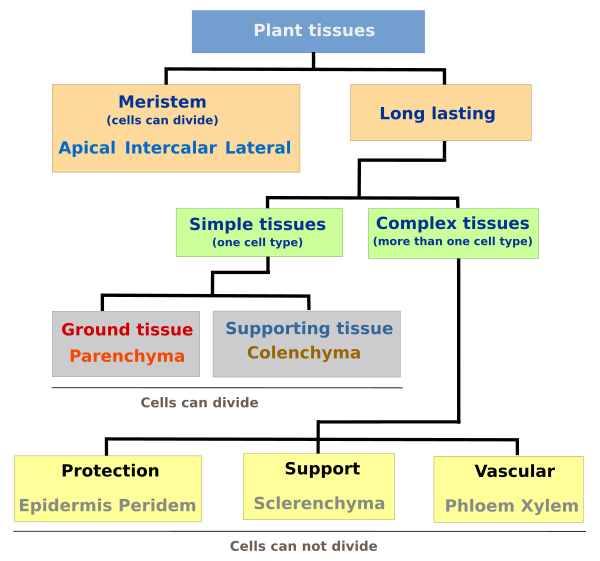When talking about the features of the tissues of plants, one has to keep in mind their evolutionary history. In the middle Paleozoic period, about 450 to 500 million years ago, plants began to colonize the land, where the environment offered some advantages over the aquatic environment: more hours of light, more light intensity, and more free movement of CO2. In return, plants had to solve new challenges, most of them related to obtaining and retaining water, keeping an erect body, and the dispersion of seeds through the air. To solve these problems, plants got more complexes. Thus, they grouped specialized cells to form tissues with specific functions that were able to cope with these new challenges. In plants, tissues form tissue systems. According to topographical locations, the term tissue system (Sachs, 1875) is used to highlight the organization of tissues into larger entities. At higher level, different tissue systems are grouped to form organs.
The features of plant cells and tissues are derived from their activities and functions:
Water. All living organisms depend on water, but plant cells maintain a strong relationship with water. They use water as a hydraulic tool. Since plants lack contractile structures such as muscle cells, they evolved to take advantage of the physical properties of water to generate forces for fluid conduction, to grow, and to produce movement in some species. The movement of carnivorous plants to trap insects or the movement of sunflowers to follow the sun are the results of water-based forces. When water is transpired through the leave stomata, the evaporated water molecules are immediately replaced by other water molecules in the leave. As a chain, the water molecules of the leaf are replaced by those coming through the petiole, those from the stem, and ultimately from the root, which takes water from the soil. The energy gradient between the atmospheric water and groundwater is enough to propel water many meters along the stems of trees. On the other hand, through concentration gradients, cells are able to generate hydraulic forces for cell growth and for transporting organic substances from the leaves to other plant organs. So strong hydraulic forces are generated that they can break rocks.
Autotrophes. Plants contain chlorophyll and are photoautotrophs. It means that they use the sunlight, water, and minerals to synthesize organic molecules, such as carbohydrates, proteins, lipids, and nucleotides. The phytochromes are able to detect changes in light-dark cycles and therefore anticipate blossoming and stem sprouting. A feature of plants is that they do not generate many waste products from their metabolic activity, except for oxygen. Animals have a digestive system and an excretory system that continuously produce waste products. However, plants develop a metabolism that is almost clean regarding waste metabolites.
Can't move. Since plants cannot move, they protect themselves from herbivores and other animals by making defensive structures like spines or synthesizing toxic and repellent substances. We use many of these substances, such as spices and food coloring, for cooking or drugs for healthcare. In addition, plants have to fight against other plants for environmental resources like sunlight, water, and nutrients, which influence the evolution and innovation of structures in all plant species.
Always growing. Plants grow continuously during their lifetimes thanks to the activity of the meristems. Unlike animals, some plant species may live for hundreds of years, and always produce new cells, while other species live and die within a few months. Vascular plants produce seeds, within which there is an embryo that develops and grows thanks to the activity of embryonary tissues and meristems. As the plant develops, meristems remain in some part of the plant and allow the growth of the plant organs.
Tissues may be defined as a group of cells that perform a function and are organized in a specific manner. Plant tissues have been traditionally grouped into the following tissue systems: protection (epidermis and periderm), ground tissues (parenchyma, collenchyma, and sclerenchyma), and vascular (xylem and phloem) (Figure 1).

The protection system allows plants to survive in dry and variable environments. It includes the outer tissues of the plant: the epidermis and periderm. Cells of these tissues are covered by cutin, suberin, and waxes that prevent the water loss. Furthermore, in the epidermis, plants develop stomata, which are associations of specialized cells for regulating transpiration and gas interchange between the plant and the environment.
The ground systemThe ground system is mainly involved in metabolic and mechanical support functions. A large proportion of the living tissues of the plant are the ground system, which is mostly parenchymal tissue. The ground system performs functions like photosynthesis and storage of different types of substances. Furthermore, it contains cells specialized in mechanical support like collenchyma and sclerenchyma, which keep the body of many herbaceous plants upright and contribute to the final shape of many plant organs. Once plants grow and get a larger body, the main support function is transferred to the vascular tissue.
The vascular system is one of the most relevant novelties during plant evolution because it communicates the different organs and parts of the plant by transporting molecules and water. This system is composed of phloem, which transports organic substances diluted in water, and xylem, which transports mainly water and inorganic substances. Besides communication, the vascular system became the main support tissue in larger plants like trees and bushes. Both communication and mechanical support led plants to increase in size and to colonize many dry territories. Only vascular plants contain true conducting tissues.
Plant tissues may be classified in other ways. For instance, according to the cell diversity found in the different tissues, there are simple tissues with only one type of cell, such as parenchyma, and complex tissues with several cell types, like protection and vascular tissues (Figure 2).

Tissues and tissue systems are grouped to form plant organs that can be classified as vegetative, such as the root (organ responsible for water and salt uptake), the stem (organ for the transport of substances, to sustain the aerial plant body, and sometimes to carry out photosynthesis), and the leaf (organ that captures solar energy to perform photosynthesis and is responsible for gas and water regulation). Others are classified as reproductive organs, such as the flower, seed, and fruit. Tissue systems are distributed in characteristic patterns, depending on the organ.
Before going into the study of each tissue and organ, it is necessary to understand two key features of plants:
1.- Plant cells have an extracellular structure that covers their plasma membrane, and is synthesized and released by the cell. This structure is the cell wall. It determines the size and shape of the cells, the texture of the tissue, and the form of the organs. Different cell types are identified by the morphological structure and chemical composition of their cell walls. The primary cell wall is mainly made of cellulose and hemicellulose, and it is formed during cell growth. The secondary cell wall is characteristic of some specialized cells and is mostly deposited when the primary wall stops growing. The primary cell walls of neighboring cells are separated by a molecular layer called the middle lamella. All plant cells show a primary cell wall, and only some types, in addition, show secondary cell walls.
2.- Plants develop and grow from an embryonic to an adult body thanks to the activity of meristems. The initial growth of plants, and the only one in some groups, is the growth in length. This is referred to as primary growth, which is produced by the activity of a group of meristematic cells found at the tip of the stems and roots, as well as at the base of the internodes. These groups of cells are the primary meristems. In addition, some groups of plants can also grow in thickness, a type of growth known as secondary growth, which depends on the activity of another type of meristem known as secondary meristems.
-
Bibliography ↷
-
Crang R, Lyons-Sobaski, S, Wise R. 2018. Plant anatomy: a concept-based approach to the structure of seed plants. Springer International Publishing. ISBN: 978-3-319-77208-0.
Evert, RF. 2006. Esau's plant anatomy: meristems, cells, and tissues of the plant body: their structure, function, and development. Third edition. John Wiley & Sons.
Sachs J. 1875. Text-book of botany: morpholoical and physiological. Clarendon Press. London.
-
